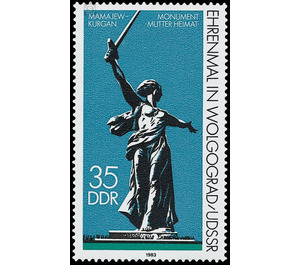Commemorative stamp series - Germany / German Democratic Republic 1983 - 35 Pfennig
Theme: Architecture
| Country | Germany / German Democratic Republic |
| Issue Date | 1983 |
| Face Value | 35.00 |
| Color | blue |
| Perforation | K 14 |
| Printing Type | Rotogravure 2 |
| Stamp Type | Postage stamp |
| Item Type | Stamp |
| Chronological Issue Number | 2572 |
| Chronological Chapter | GER-DDR |
| SID | 525910 |
| In 19 Wishlists | |
Wolgograd Memorial, USSR With a depiction from the Volgograd Memorial, USSR, the Ministry of Posts and Telecommunications of the German Democratic Republic issues a multicolored postage stamp. Special cancellation from 4 October to 3 December 1983 Cenotaph in Volgograd / USSR Stalingrad - synonym for the turn of the Volga, which marks the beginning of the defeat in the fascist robbery war. But Stalingrad is synonymous in particular synonymous with the heroism of the soldiers with the red star. Stalingrad - synonymous with the invincibility of the first socialist country in the world. When the fascist Wehrmacht wanted to take the strategically important city on the Volga at any price in the summer of 1942, the war-bleeding Soviet country formed its heroically fighting soldiers to defend its homeland. Under the call "Communists and Komsomolts, onwards!" For 125 days and nights they fought each house for every meter of native soil. Who counts the exploits? Tens of thousands of names entered the glorious history of the turn of the Volga. When the Battle of Stalingrad fell silent 40 years ago, up to 1,250 pieces of shrapnel were found on every square meter of the Mamai Hill. In the spring of 1943 the grass did not appear on this splintered earth. Immediately after the victory in the Great Patriotic War, the idea arose to build a memorial to the living to glory and the dead to honor on the Mamai Hill of the hero city. For the best draft of a memorandum, a competition was advertised, won by the People's Artist of the USSR, sculptor Yevgeny Wushetich. He was also the chief sculptor in the collective that built the memorial over the course of eight years. At the opening ceremony on October 15, 1967, LES Brezhnev said, "Stones live longer than humans, and only humans lend immortality to everything connected with their heroic deeds." The heroic exploit has made the stones of Mamai Hill immortal, years and decades will pass, new generations will take us off, but here, at the foot of the majestic monument of victory, the heroes' grandchildren and great-grandchildren will come, lay flowers, and bring children here. who have fallen as they defended the eternal fire of life, they will remember the past and dream of the future. " The memorable site of the Mamai Hill is home to an avenue of pyramidal poplars, the "Life and Death" Square, the Heroes' Square, the Hall of Fame, the sculpture in the Square of Mourning, and the main statue, Mother Motherland. For the most important buildings alone, the volume of earthworks was one million cubic meters. 20,000 cubic meters of concrete and more than 25,000 t of metal structures were used. Far above, the sculpture of a woman striving upwards towers over the summit of the Mamai hill. The figure of Mother Mother is made of monolithic reinforced concrete. It is believed that a gust of wind hurls her scarf back, strikes the folds of the robe around her legs. The figure is 52 m high, the arm length is 20 m. But the piece of the over the shoulder struck scarves is 250 t. The statue is not directly attached to the foundation, but stands on a 2.25 m high plate and gets hold only by its own weight. The 16 m high foundation lies under a heaped up Kurgan - the old Russian burial mound form. With a rousing movement, the "Motherland" tears up her sword, she points to the Volga, and it is thought that she heard her call: sons and daughters, defending their homeland in difficult times.


